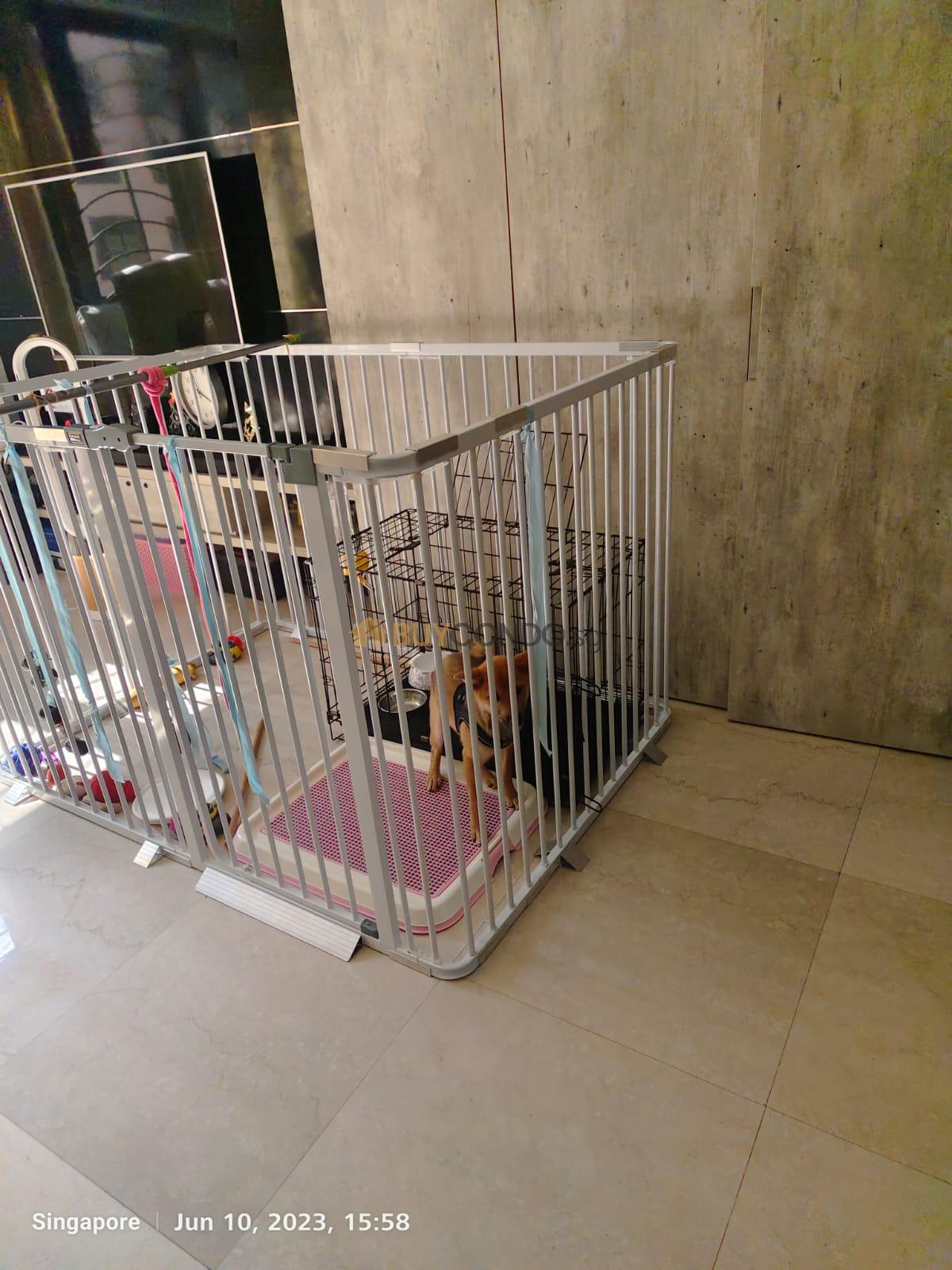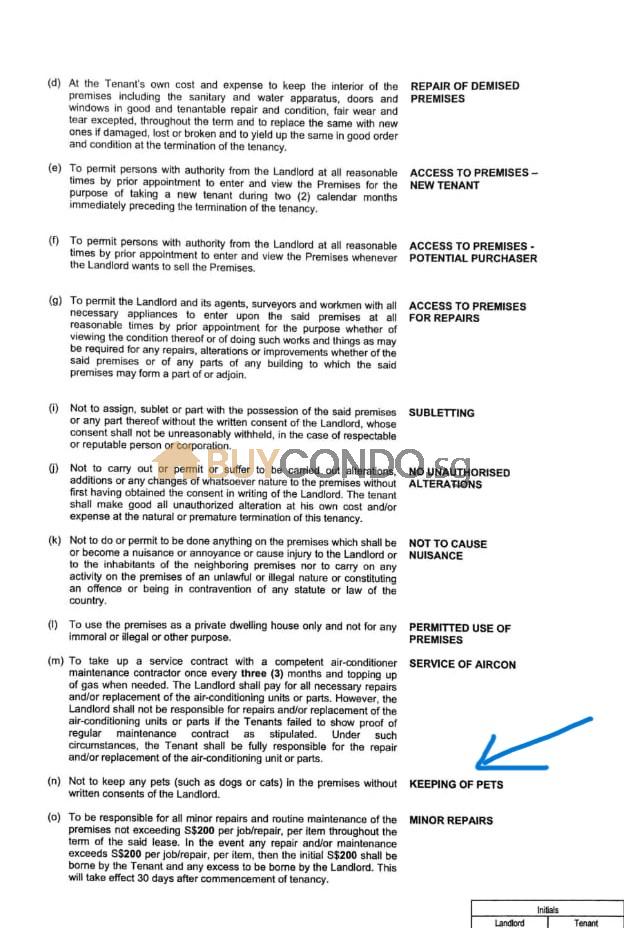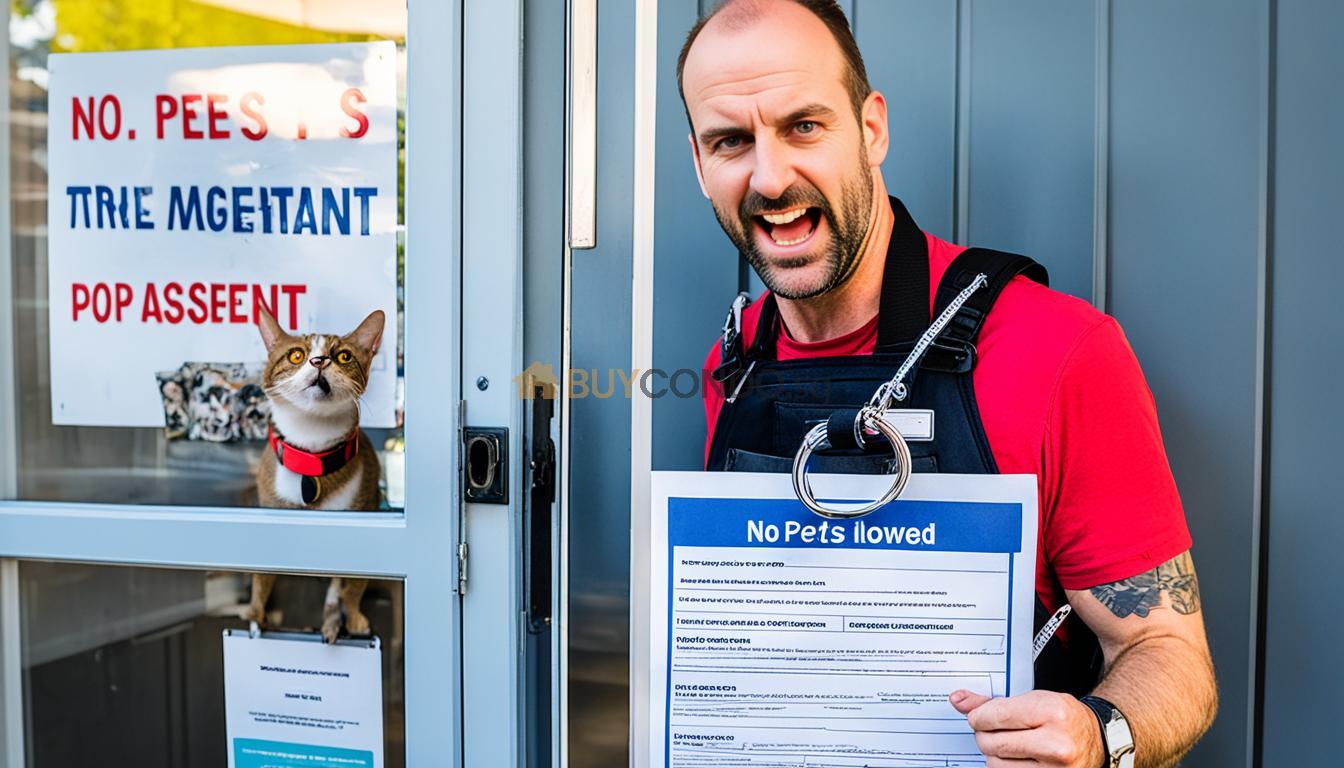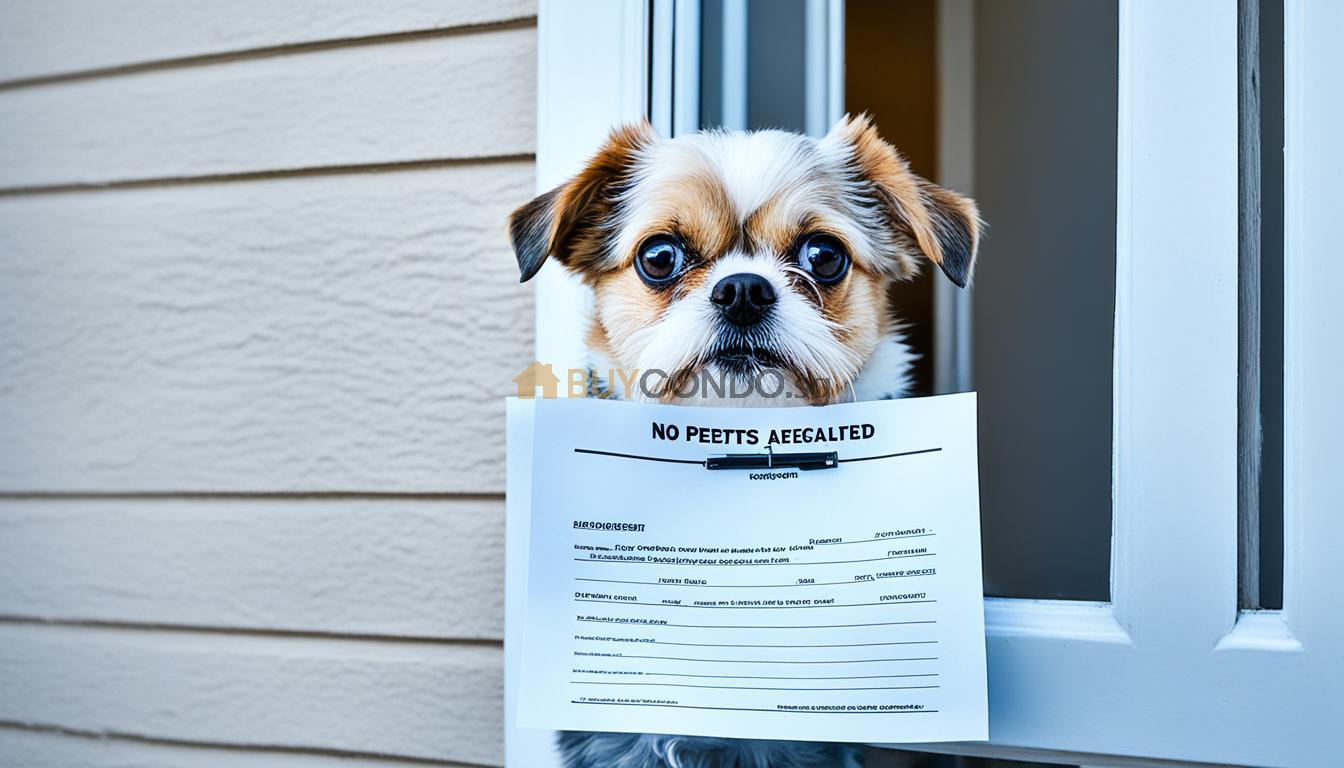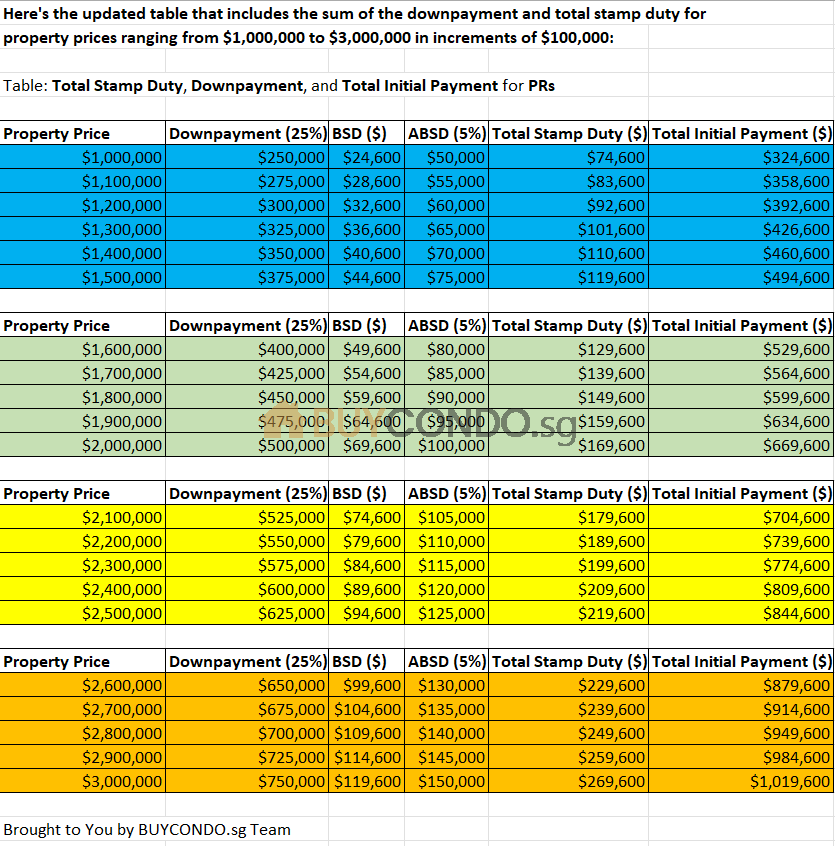Found out that your tenant having a pet without consent
Did you know that unauthorized pets in rental properties are more common than you might think? According to a recent study, over 50% of landlords have dealt with tenants who had unpermitted pets. This surprising statistic highlights the importance of knowing how to handle tenant issues related to unauthorized pets in rentals.
We have a Condo property that has been leased out. The landlord has pop by just to pick up from mails. However, to their surprise, they saw the tenant was keeping pets in the apartment without the consent of the landlord or landlord’s representative.
In conjunction with that, we are also in the midst of selling the condo with tenancy.
What can be done at the point of time?
Referred back to the Tenancy Agreement.
What are the Owner’s Rights and Options
- they keep a pet without telling. Breach of contract.
- Impose additional terms for them to agree if they want the keep a pet.
- Example request for a professional cleaning at end of lease etc
Discovering that a tenant has an unauthorized pet in a rental property can be a challenging situation for landlords and property managers. It not only raises concerns about property damage and liability but also requires careful navigation of legal considerations and effective communication with tenants.
The parties may also wish to trace through at all recorded communications if the pet request has it been officially informed that may have been missed out to avoid misunderstanding.
Key Takeaways: Found out that your tenant having a pet without consent
- Unauthorized pets in rental properties are a common issue faced by landlords.
- Handling tenant issues related to unpermitted pets requires careful navigation of legal considerations.
- Effective communication with tenants is crucial in addressing unauthorized pet situations.
- Clear pet policies and consistent enforcement can help prevent pet-related issues in the future.
- Regular inspections and follow-up can ensure compliance with pet policies in rental properties.
Unauthorized pets in rental properties can have significant consequences for both landlords and tenants. It’s essential to evaluate the risks associated with tenants having pets and understand the potential property damage and liability that can arise from unauthorized pets.
Evaluating the Risks of Tenants with Pets
Allowing tenants to have pets comes with inherent risks. Some of the potential risks include:
- Property Damage: Pets, especially when untrained or unsupervised, can cause damage to the rental property, such as scratching doors, chewing on furniture, or soiling carpets.
- Noise Disturbances: Pets can create noise disturbances, especially if they are not properly trained or experience separation anxiety.
- Allergies and Health Concerns: Some tenants may have allergies or health conditions that can be triggered by pets, causing discomfort and potential legal issues.
Assessing Property Damage and Liability
Unauthorized pets can not only cause physical damage to the rental property but also create liability issues for landlords. Here are some potential liability concerns:
- Personal Injury: If a tenant or visitor is bitten or injured by an unauthorized pet, the landlord may be held responsible for medical expenses and legal actions.
- Insurance Coverage: Unauthorized pets may void the landlord’s insurance coverage, exposing them to financial risks in the event of property damage or personal injury caused by the pet.
- Neighboring Tenants: Unauthorized pets can create conflicts and disturbances with neighboring tenants, leading to complaints and potential legal disputes.
To better understand the risks and possible liability, landlords should consult with legal professionals and insurance providers to ensure they have adequate coverage and take necessary precautions to prevent unauthorized pets in their rental properties.
The initial discovery of an unauthorized pet in a rental property can be an unsettling situation for landlords and property managers. It often occurs during routine inspections, maintenance visits, or through reports from neighboring tenants. It is crucial for landlords to be vigilant and prepared to handle these situations promptly and effectively to address the issue at hand.
As a landlord, it is my responsibility to ensure that all tenants are abiding by the terms of their lease agreements, including any policies regarding pets. When I first discover an unauthorized pet, I take immediate action to investigate the situation and gather necessary evidence.
One way to identify an unauthorized pet is through routine inspections. These inspections allow me to assess the condition of the property and check for any signs of pets, such as pet hair, pet odors, or scratches on the furniture or walls. Additionally, maintenance visits can provide opportunities to uncover the presence of an unauthorized pet, as tenants may inadvertently reveal their pet’s existence during these visits.
Furthermore, reports from neighboring tenants can be a valuable source of information when it comes to identifying an unauthorized pet. Neighbors may notice the sound of barking or witness the tenant taking the pet in and out of the property. Establishing an open line of communication with neighbors can help me stay informed and address any potential issues proactively.
Once I have identified an unauthorized pet, I follow the appropriate steps to address the situation, ensuring that I handle it in a fair and professional manner. This includes reviewing the lease agreement and pet policy, communicating with the tenant, and taking any necessary legal actions if the tenant fails to comply.
| Steps for Handling an Unauthorized Pet | |
|---|---|
| 1. Review the lease agreement and pet policy | |
| 2. Notify the tenant in writing about the unauthorized pet | |
| 3. Provide a deadline for the tenant to remove the pet | |
| 4. Conduct follow-up inspections to ensure compliance | |
| 5. Take legal actions if necessary |
Identifying an unauthorized pet in a rental property is an essential part of maintaining a safe and compliant living environment for all tenants. By being proactive, observant, and taking appropriate action, landlords can effectively address these situations and uphold the terms of their lease agreements.
What To Do If Your Tenant Has A Pet Without Permission?
Steps for Addressing the Situation
When faced with a tenant who has a pet without permission, it’s crucial to take the appropriate steps to address the situation promptly and effectively. By following these steps, landlords can mitigate any potential conflicts and rectify the unauthorized pet situation:
- Send an Official Notice: Begin by sending an official notice to the tenant, clearly stating that they have violated the lease agreement by having a pet without permission. Include specific details about the pet and the timeframe for resolving the situation.
- Discuss the Violation: Schedule a meeting with the tenant to discuss the violation of the lease agreement. Clearly communicate the potential consequences and emphasize the importance of adhering to the agreed-upon terms.
- Provide a Timeline: Give the tenant a specific timeline within which they must remove the unauthorized pet from the premises or seek written permission if they wish to keep the pet. This timeline should be reasonable and allow the tenant sufficient time to rectify the situation.
- Document Communication: Keep a record of all communication with the tenant, including the official notice, meeting discussions, and any agreements reached. This documentation will be valuable if further action is necessary.
- Follow-up: Regularly follow up with the tenant to ensure compliance with the agreed-upon timeline. If the tenant fails to comply, further action may be required.
Effective Communication with the Tenant
Communication plays a crucial role in resolving the unauthorized pet situation amicably. Here are some tips for effective communication with the tenant:
- Remain Calm and Professional: Approach the situation with a calm demeanor and maintain a professional tone during discussions with the tenant. This approach will help minimize tension and encourage a more cooperative environment.
- Actively Listen: Give the tenant an opportunity to express their perspective and concerns. Actively listen to their side of the story, which can help foster understanding and potentially lead to a mutually agreeable resolution.
- Offer Solutions: Instead of solely focusing on the problem, work with the tenant to find potential solutions. Discuss alternatives such as seeking written permission for the pet or exploring other housing options that allow pets.
- Be Firm but Fair: While it’s important to enforce the lease agreement, strive to maintain fairness throughout the process. Consider the tenant’s history, their willingness to rectify the situation, and any extenuating circumstances that may have prompted them to keep a pet without permission.
By following these steps and maintaining effective communication with the tenant, landlords can address the unauthorized pet situation while preserving their professional relationship with the tenant.
Reviewing Your Rental Agreement and Pet Policy
As a landlord, it is crucial to carefully review your rental agreement and pet policy to ensure that you have clearly stated regulations regarding pets. The rental agreement should clearly outline the rules and restrictions related to pets in the rental property. This includes specifying whether pets are allowed, the types and sizes of pets permitted, any limitations or requirements such as pet deposits or additional fees, and the consequences for violating the pet policy.
By reviewing and revisiting your rental agreement and pet policy, you can ensure that they are comprehensive and up-to-date, providing you with the necessary framework to effectively manage pet-related issues that may arise with your tenants. Having clear and specific pet policies will help set expectations for tenants and minimize misunderstandings or disagreements regarding pets in your rental property.
Determining Violations of Rental Terms
When it comes to enforcing your pet policy, it is important to accurately determine violations of rental terms. This requires careful evaluation and assessment of the situation. If you suspect that a tenant has an unauthorized pet, you should gather evidence such as eyewitness accounts, photographs, or any other relevant documentation that supports your claim of a violation.
It is crucial to have objective and unambiguous criteria for identifying violations of rental terms. Clear and specific language in your rental agreement and pet policy will help you determine if a tenant has breached the no-pet clause or any other pet-related regulations. It is essential to approach the situation in a fair and consistent manner, making sure that you follow the guidelines outlined in your written policies and procedures.
Enforcing the No-Pet Clause Effectively
Once you have identified a violation of the no-pet clause or any other pet-related regulations, it is necessary to take appropriate action and enforce the rules effectively. Start by discussing the violation with the tenant and providing them with a written notice to remedy the situation within a specified period of time. Clearly communicate the consequences of failing to comply with the policy, such as potential lease termination or eviction.
Enforcing the no-pet clause effectively requires a consistent and assertive approach. Regular inspections and follow-up visits can help deter tenants from violating the pet policy and ensure compliance with the agreed-upon terms. It is important to document all interactions with the tenant, including written notices, conversations, and any evidence of non-compliance.
By reviewing your rental agreement and pet policy, determining violations of rental terms, and enforcing the no-pet clause effectively, you can effectively manage pet-related issues and maintain a harmonious rental environment.
Dealing with unauthorized pets in rental properties involves navigating various legal considerations. As a landlord, it is crucial to be well-informed about your rights and the rights of tenants when it comes to unauthorized pets. Understanding eviction procedures and the legal obligations related to unauthorized pets will help you handle these situations effectively and within the boundaries of the law.
When encountering unauthorized pets, it is essential to familiarize yourself with the legal options available to address the issue. Eviction for unauthorized pets may be a possibility, but it is important to follow proper procedures and ensure that your actions comply with local laws and regulations.
Tenant rights also come into play when dealing with unauthorized pets. Tenants may have the right to challenge eviction based on their pet ownership, particularly if they can present valid reasons for having the pet despite not obtaining prior permission. Being knowledgeable about tenant rights will guide you in handling such situations in a fair and legally compliant manner.
Consulting with a legal professional specializing in landlord-tenant law can provide valuable insights and guidance when it comes to legal considerations for unauthorized pets. They can help you understand the specific laws and regulations applicable to your jurisdiction and provide clarity on tenant rights and eviction procedures.
“Understanding the legal aspects surrounding unauthorized pets is crucial for landlords to protect their property and avoid potential legal disputes.” – Law Expert
| Legal Considerations for Unauthorized Pets | Eviction for Unauthorized Pets | Tenant Rights and Unauthorized Pets |
|---|---|---|
| Be aware of your rights as a landlord and the rights of tenants. | Follow proper eviction procedures in accordance with local laws. | Consider valid reasons tenants may present for having unauthorized pets. |
| Understand the legal options available to address unauthorized pets. | Consult with legal professionals specializing in landlord-tenant law. | Handle unauthorized pet situations in a fair and compliant manner. |
Strategies for Enforcing Pet Restrictions in Rentals
To effectively enforce pet restrictions in rentals, it is crucial for landlords to set clear expectations with tenants right from the start. By establishing and communicating pet policies clearly and consistently, landlords can create a structured environment and minimize the risks associated with unauthorized pets. However, merely setting expectations is not enough. It is equally important to implement pet rules and consequences consistently throughout the tenancy to maintain fairness and accountability.
Setting Clear Expectations with Tenants
When it comes to enforcing pet restrictions, communication is key. Landlords should clearly outline their pet policies from the beginning, including any restrictions, rules, and regulations. This can be done through the rental agreement, addendums, or a separate pet policy document. By ensuring tenants understand the restrictions and responsibilities associated with having pets, landlords can set the stage for compliance.
During the tenant screening process, landlords should discuss the pet policies with potential tenants to ensure mutual understanding and agreement. This can help avoid future conflicts and surprises related to pets. Additionally, it’s important to provide tenants with written documentation of the pet policies, which they can refer to throughout their tenancy.
Implementing Pet Rules and Consequences Consistently
Consistency is key when it comes to enforcing pet rules and consequences. Landlords should establish a system for monitoring and enforcing pet restrictions, ensuring that all tenants are treated fairly and equally. This can be achieved through regular inspections, where landlords can check for any unauthorized pets and ensure compliance with the pet policies.
When an unauthorized pet is discovered, landlords should take prompt action in accordance with the terms outlined in the rental agreement or pet policy. This may include sending a notice to the tenant, requesting the removal of the pet within a specified timeframe, or imposing fines or other consequences for non-compliance. By implementing consequences consistently, landlords can maintain a harmonious living environment for all tenants and deter future violations.
Preventive Measures: Avoiding Pet-Related Issues in the Future
As a landlord, taking preventive measures is crucial to avoid pet-related issues in the future. By implementing proactive strategies, you can create a safe and harmonious environment for both tenants and their pets. Two key preventive measures include creating a comprehensive pet policy and conducting regular inspections with consistent follow-up.
Creating a Comprehensive Pet Policy
A comprehensive pet policy is essential to set clear guidelines and expectations for tenants with pets. It should outline the rules and regulations related to pet ownership, such as breed restrictions, leash requirements, and waste disposal. By clearly communicating these guidelines to tenants from the start, you can minimize the risk of pet-related issues arising in your rental property.
Regular Inspections and Consistent Follow-up
Regular inspections are crucial to ensure compliance with your pet policy and identify any potential issues early on. During inspections, look for signs of pet damage, unauthorized pets, and any violations of the pet policy. If necessary, take appropriate action and follow up with tenants to address any issues promptly. Consistency is key to maintaining a pet-friendly environment while upholding the rules and regulations set forth in your pet policy.
| Benefits of Regular Inspections and Follow-up: |
|---|
| Early detection: Identify and address pet-related issues before they escalate. |
| Maintain property condition: Ensure that the rental property remains in good condition despite pets being present. |
| Build trust: Show tenants that you are attentive and committed to providing a safe and comfortable living environment for both them and their pets. |
| Encourage compliance: Regular inspections and follow-up can motivate tenants to adhere to the pet policy, knowing that there are consequences for non-compliance. |
| Resolve issues promptly: Addressing pet-related concerns in a timely manner can prevent them from becoming larger and more challenging to resolve. |
Conclusion
Managing unauthorized pets in rental properties requires a systematic approach and clear communication with tenants. It is crucial for landlords to understand the impact of unauthorized pets, assess the risks involved, and take the appropriate steps to address the situation. By following these guidelines and implementing preventive measures, landlords can effectively handle tenant issues related to pets and maintain a harmonious rental environment.
First and foremost, it is important to understand the implications of unauthorized pets in rental properties. These pets can cause damage to the property and create liability issues for the landlord. By evaluating the risks associated with tenants having pets and assessing potential property damage and liability, landlords can better address the situation.
When faced with the discovery of an unauthorized pet, it is essential to take prompt and appropriate action. This includes sending an official notice to the tenant, discussing the violation of the lease agreement, and providing a timeline for the tenant to rectify the situation. Effective communication with the tenant throughout the process is key to resolving the issue in a professional manner.
To avoid future pet-related issues, landlords should review and update their rental agreements and pet policies. Clear expectations and rules regarding pets should be communicated consistently to all tenants. Conducting regular inspections and following up on compliance will help ensure a pet-friendly environment that respects the rights of both tenants and landlords.
Conclusion: Handling unauthorized pets in rentals requires a systematic approach and clear communication with tenants. Understanding the impact of unauthorized pets, following the appropriate steps, and implementing preventive measures enables landlords to effectively manage tenant issues related to pets and maintain a harmonious rental environment.
FAQ : Found out that your tenant having a pet without consent
When faced with a tenant having a pet without permission, it’s important to follow a set of steps to address the situation. This includes sending an official notice to the tenant, discussing the violation of the lease agreement, and providing a timeline for the tenant to remedy the situation. Effective communication with the tenant is crucial to resolve the issue amicably.
Unauthorized pets can cause damage to the property and create liability issues for the landlord. It’s crucial to evaluate the risks associated with tenants having pets and understand the potential property damage and liability that can arise from unauthorized pets.
Landlords should be aware of their rights and the rights of tenants when it comes to unauthorized pets. It’s essential to understand eviction procedures and the legal obligations related to unauthorized pets.
How can I effectively enforce pet restrictions in my rental property?
To effectively enforce pet restrictions in rentals, landlords should set clear expectations with tenants from the start. This includes communicating the pet policies clearly and consistently. It’s crucial to implement pet rules and consequences consistently to maintain a fair and structured environment for all tenants.
Landlords can take preventive measures to avoid pet-related issues in the future. This includes creating a comprehensive pet policy that clearly outlines the rules and regulations for pets in the rental property. Regular inspections and consistent follow-up can help ensure compliance with the pet policy.



